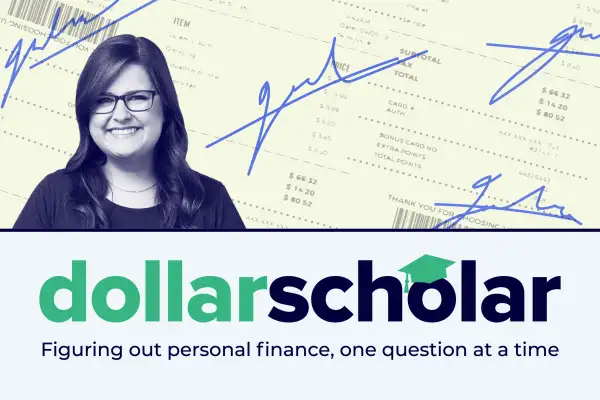Dollar Scholar Asks: Why Do We Sign Credit Card Receipts?

This is an excerpt from Dollar Scholar, the Money newsletter where news editor Julia Glum teaches you the modern money lessons you NEED to know. Don't miss the next issue! Sign up at money.com/subscribe and join our community of 160,000+ Scholars.
Nerd alert: One of my favorite authors, Maggie Stiefvater, released the conclusion to the Dreamer Trilogy this fall. I haven't read it yet, but I've ordered a signed copy — and Stiefvater is famous for her autograph.
She specifically designed it to stand out. And trust me, it’s badass.
My own signature is nothing special, which is fine, because I only use it when I have to, like, sign a receipt at the bodega. And I'm pretty sure the cashier doesn't care (or even really look at) what I write, whether that's a barely legible JG or a perfectly neat J u l i a G l u m.
Karen Sylvester, senior director of compliance education at payments association EPCOR, says merchants ask customers to sign receipts mostly so they have a record of purchases. It’s proof that I actually authorized a transaction.
This used to be important because of credit card disputes, or chargebacks. Sylvester says card issuers wanted merchants to keep receipts because, a lot of the time, they were “the one left holding the bag” when people demanded their money back.
Say I told my card issuer, “Hey, I didn’t buy $50 worth of Reese’s peanut butter cups at the bodega at 2 a.m.” The company could then turn around and ask the corner store to produce a copy of my receipt. If it could — and the signature matched the one they had on file for me — they could come back to me and say, “Uh, yeah, you did. We’re not refunding you.”
This was reasonable because, for decades, physical signatures were the main way of legitimizing a contract. In fact, NPR reports that credit card signatures have roots in the Talmud, an ancient Jewish text.
But there have always been holes in this logic. The signature verification method isn't a terribly effective way of preventing fraud, and it's cumbersome. Decades ago, for the sake of speed, fast food restaurants like Wendy’s decided not to make people sign for orders under $25.
Put simply: Times changed.
While signatures on receipts used to be "an important security tool," says Andrew Hopkins, senior vice president of global products and pricing at Discover, they've become "no longer useful."
That’s also why the major card issuers — American Express, Discover, Mastercard and Visa — stopped requiring signatures for card transactions in 2018. After all, there are more advanced ways to verify my identity and confirm my purchases.
So why do some places still ask for signatures?
Jared Drieling, chief innovation officer at payments firm The Strawhecker Group, says that has to do with a method called EMV, which is connected to chip and PIN cards. Migrating to EMV is safer, but it requires merchants to update their point-of-sale terminals (aka card machines). While that’s NBD for big franchises like Target, it can be expensive for smaller businesses like the local gas station.
“If you’re a merchant and don’t have a terminal that can process a chip card, your alternative would be to go back to the old route,” Drieling says.
That means making me sign a receipt — and then saving it just in case the transaction comes back to haunt them. But because that's so rare nowadays, the specifics of what my signature looks like don't usually matter.
“Many consumers have adapted to the habit or expectation of signature upon transaction, but fraud technology and commerce have been moving away from this practice for some time,” Hopkins adds.
Merchants have historically used signatures on receipts as a record of transaction to protect against fraud or chargeback. But the industry has since moved away from that standard.
These days, if a place asks me to sign a receipt, it’s probably because they haven’t migrated yet to EMV. I should give them my John Hancock to make the cashier’s life easier, but I don’t need to stress about it.
More from Money:
Is It Risky to Give My Phone Number to Stores and Restaurants?
Here's Exactly How Long You Should Keep Receipts, According to Experts
Does Writing 'See ID' on the Back of a Credit Card Actually Help Prevent Fraud?
